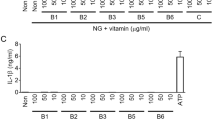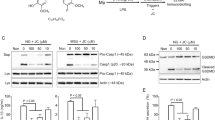Abstract
Poly-gamma-glutamic acid (γ-PGA) is a natural, edible and non-toxic polymer synthesized by Bacillus subtilis and is suggested as a safe biomaterial for the use in hydrogels and vaccine adjuvants. However, the effect of γ-PGA on inflammasome activation has not yet been studied in macrophages. Inflammasomes, which are intracellular multi-protein complexes, promote acute and chronic inflammation via interleukin-1β or interleukin-18 maturation, and they are known targets for metabolic syndromes and cancer. In this study, we observed that γ-PGA attenuated NLRP3, NLRC4 and AIM2 inflammasome activation, whereas it upregulated pro-inflammatory cytokine expression in human and murine macrophages. Although γ-PGA had conflicting effects on cytokine production and maturation, it clearly alleviated the severity of lipopolysaccharide-induced endotoxin shock in an animal model. Thus, we suggest γ-PGA as a candidate to control inflammasome-mediated disorders.
This is a preview of subscription content, access via your institution
Access options
Subscribe to this journal
Receive 12 digital issues and online access to articles
$119.00 per year
only $9.92 per issue
Buy this article
- Purchase on Springer Link
- Instant access to full article PDF
Prices may be subject to local taxes which are calculated during checkout





Similar content being viewed by others
References
Ashiuchi M, Kamei T, Baek DH, Shin SY, Sung MH, Soda K et al. Isolation of Bacillus subtilis (chungkookjang), a poly-gamma-glutamate producer with high genetic competence. Appl Microbiol Biotechnol 2001; 57: 764–769.
Ogunleye A, Bhat A, Irorere VU, Hill D, Williams C, Radecka I . Poly-gamma-glutamic acid: production, properties and applications. Microbiology 2015; 161: 1–17.
Shih IL, Van YT . The production of poly-(gamma-glutamic acid) from microorganisms and its various applications. Bioresour Technol 2001; 79: 207–225.
Lee EH, Son WC, Lee SE, Kim BH . Anti-obesity effects of poly-gamma-glutamic acid with or without isoflavones on high-fat diet induced obese mice. Biosci Biotechnol Biochem 2013; 77: 1694–1702.
Moraes LP, Brito PN, Alegre RM . The Existing Studies on Biosynthesis of Poly(ɣ-glutamic acid) by Fermentation. Food Public Health 2013; 3: 28–36.
Takeuchi O, Akira S . Pattern recognition receptors and inflammation. Cell 2010; 140: 805–820.
Schroder K, Zhou R, Tschopp J . The NLRP3 inflammasome: a sensor for metabolic danger? Science 2010; 327: 296–300.
Schroder K, Tschopp J . The inflammasomes. Cell 2010; 140: 821–832.
Lee GS . Inflammasomes, multi-cellular protein complex in myeloid cells, induce several metabolic diseases via interleukin-1β maturation. J Biomed Res 2013; 14: 195–200.
Lee GS, Subramanian N, Kim AI, Aksentijevich I, Goldbach-Mansky R, Sacks DB et al. The calcium-sensing receptor regulates the NLRP3 inflammasome through Ca2+ and cAMP. Nature 2012; 492: 123–127.
Rathinam VA, Vanaja SK, Fitzgerald KA . Regulation of inflammasome signaling. Nat Immunol 2012; 13: 333–342.
Kastner DL, Aksentijevich I, Goldbach-Mansky R . Autoinflammatory disease reloaded: a clinical perspective. Cell 2010; 140: 784–790.
Strowig T, Henao-Mejia J, Elinav E, Flavell R . Inflammasomes in health and disease. Nature 2012; 481: 278–286.
Kolb R, Liu GH, Janowski AM, Sutterwala FS, Zhang W . Inflammasomes in cancer: a double-edged sword. Protein Cell 2014; 5: 12–20.
Wen H, Ting JP, O'Neill LA . A role for the NLRP3 inflammasome in metabolic diseases—did Warburg miss inflammation? Nat Immunol 2012; 13: 352–357.
Kim J, Ahn H, Woo HM, Lee E, Lee GS . Characterization of porcine NLRP3 inflammasome activation and its upstream mechanism. Vet Res Commun 2014; 38: 193–200.
Ahn H, Kim J, Jeung EB, Lee GS . Dimethyl sulfoxide inhibits NLRP3 inflammasome activation. Immunobiology 2014; 219: 315–322.
Ahn H, Kim J, Lee MJ, Kim YJ, Cho YW, Lee GS . Methylsulfonylmethane inhibits NLRP3 inflammasome activation. Cytokine 2014; 71: 223–231.
Kim J, Ahn H, Han BC, Lee SH, Cho YW, Kim CH et al. Korean red ginseng extracts inhibit NLRP3 and AIM2 inflammasome activation. Immunol Lett 2014; 158: 143–150.
Lee SW, Park HJ, Park SH, Kim N, Hong S . Immunomodulatory effect of poly-gamma-glutamic acid derived from Bacillus subtilis on natural killer dendritic cells. Biochem Biophys Res Commun 2014; 443: 413–421.
Lee TY, Kim YH, Yoon SW, Choi JC, Yang JM, Kim CJ et al. Oral administration of poly-gamma-glutamate induces TLR4- and dendritic cell-dependent antitumor effect. Cancer Immunol Immunother 2009; 58: 1781–1794.
Uto T, Wang X, Sato K, Haraguchi M, Akagi T, Akashi M et al. Targeting of antigen to dendritic cells with poly(gamma-glutamic acid) nanoparticles induces antigen-specific humoral and cellular immunity. J Immunol 2007; 178: 2979–2986.
Lee W, Lee SH, Ahn DG, Cho H, Sung MH, Han SH et al. The antiviral activity of poly-gamma-glutamic acid, a polypeptide secreted by Bacillus sp., through induction of CD14-dependent type I interferon responses. Biomaterials 2013; 34: 9700–9708.
Mariathasan S, Weiss DS, Newton K, McBride J, O'Rourke K, Roose-Girma M et al. Cryopyrin activates the inflammasome in response to toxins and ATP. Nature 2006; 440: 228–232.
Bauer C, Duewell P, Mayer C, Lehr HA, Fitzgerald KA, Dauer M et al. Colitis induced in mice with dextran sulfate sodium (DSS) is mediated by the NLRP3 inflammasome. Gut 2010; 59: 1192–1199.
Davaatseren M, Hwang JT, Park JH, Kim MS, Wang S, Sung MJ . Poly-gamma-glutamic acid attenuates angiogenesis and inflammation in experimental colitis. Mediators Inflamm 2013; 2013: 982383.
Kim S, Yang JY, Lee K, Oh KH, Gi M, Kim JM et al. Bacillus subtilis-specific poly-gamma-glutamic acid regulates development pathways of naive CD4(+) T cells through antigen-presenting cell-dependent and -independent mechanisms. Int Immunol 2009; 21: 977–990.
Lee K, Hwang S, Paik DJ, Kim WK, Kim JM, Youn J . Bacillus-derived poly-gamma-glutamic acid reciprocally regulates the differentiation of T helper 17 and regulatory T cells and attenuates experimental autoimmune encephalomyelitis. Clin Exp Immunol 2012; 170: 66–76.
Kim TW, Lee TY, Bae HC, Hahm JH, Kim YH, Park C et al. Oral administration of high molecular mass poly-gamma-glutamate induces NK cell-mediated antitumor immunity. J Immunol 2007; 179: 775–780.
Moll M, Kuemmerle-Deschner JB . Inflammasome and cytokine blocking strategies in autoinflammatory disorders. Clin Immunol 2013; 147: 242–275.
Kagan JC, Medzhitov R . Phosphoinositide-mediated adaptor recruitment controls Toll-like receptor signaling. Cell 2006; 125: 943–955.
Yamamoto M, Sato S, Hemmi H, Uematsu S, Hoshino K, Kaisho T et al. TRAM is specifically involved in the Toll-like receptor 4-mediated MyD88-independent signaling pathway. Nat Immunol 2003; 4: 1144–1150.
Bauernfeind FG, Horvath G, Stutz A, Alnemri ES, MacDonald K, Speert D et al. Cutting edge: NF-kappaB activating pattern recognition and cytokine receptors license NLRP3 inflammasome activation by regulating NLRP3 expression. J Immunol 2009; 183: 787–791.
Acknowledgements
We thank Young Jin Kim (Korea Food Research Institute) for providing the cheonggukjang extracts. This research was supported by the Basic Science Research Program through the National Research Foundation of Korea (NRF) funded by the Ministry of Education, Science and Technology (NRF-2015R1A2A2A01004183).
Author information
Authors and Affiliations
Corresponding author
Ethics declarations
Competing interests
The authors declare no conflict of interest.
Additional information
Supplementary Information for this article can be found on the Cellular & Molecular Immunology website
Supplementary information
Rights and permissions
About this article
Cite this article
Ahn, H., Kang, S., Yoon, Si. et al. Poly-gamma-glutamic acid from Bacillus subtilis upregulates pro-inflammatory cytokines while inhibiting NLRP3, NLRC4 and AIM2 inflammasome activation. Cell Mol Immunol 15, 111–119 (2018). https://doi.org/10.1038/cmi.2016.13
Received:
Revised:
Accepted:
Published:
Issue Date:
DOI: https://doi.org/10.1038/cmi.2016.13
Keywords
This article is cited by
-
Immunomodulatory functional foods and their molecular mechanisms
Experimental & Molecular Medicine (2022)
-
JC2-11, a benzylideneacetophenone derivative, attenuates inflammasome activation
Scientific Reports (2022)
-
Homotypic CARD-CARD interaction is critical for the activation of NLRP1 inflammasome
Cell Death & Disease (2021)
-
Riboflavin, vitamin B2, attenuates NLRP3, NLRC4, AIM2, and non-canonical inflammasomes by the inhibition of caspase-1 activity
Scientific Reports (2020)
-
Carnosol inhibits inflammasome activation by directly targeting HSP90 to treat inflammasome-mediated diseases
Cell Death & Disease (2020)



